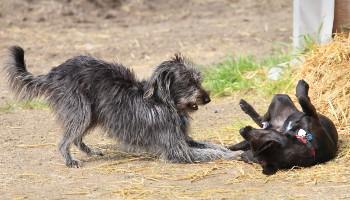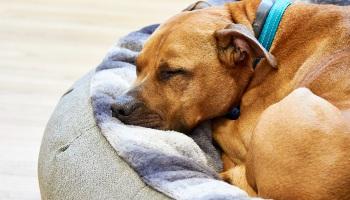Dog crates uses
- Open 'den' area – some dogs appear to benefit from having an open 'den' that they can use as a safe place where they feel secure.
- Training aid – for example, helping puppies to learn to be left alone or helping with toilet training.
- Short-term confinement – for example, if you're not around to supervise them.
- Vet advised – in some circumstances, a vet may advise the use of a crate, for example, to aid recovery after surgery.
When travelling – crates can help dogs feel secure and comfortable while travelling, for example in the back of your car.
Your dog's crate should be big enough for them to stand, turn around, lie down and stretch in. For a puppy, get a crate that's big enough for your pup to grow into. But don't travel with your puppy in their adult-sized crate – they'll be better protected in a smaller space.
Safe haven, not ‘sin bin’
Your dog’s crate should be a place where they feel secure, safe and comfortable. Crates must never be used as a punishment or to prevent unwanted behaviours such as destruction of furniture. If you are concerned about your dog or puppy’s behaviour you should contact your vet who will be able to refer you to a clinical animal behaviourist if necessary.
The following will help you turn the crate into a safe haven where your dog or puppy can feel secure:
- Add some comfortable soft bedding for your dog to lie on.
- Place some interesting, safe, chew toys inside.
- Find a location for the crate which is not in direct sunlight or in a drought.
- Placing a cover over part of the crate can help nervous dogs.
- Make sure they have access to water – use a clip-on bowl to prevent them from tipping it over.
To help your dog feel safe, secure and comfortable, read our step-by-step guide to dog crates.
Crate training guide
When it comes to the crate training process, always remember to:
- Think positive – the crate should always be associated with something pleasant.
- Be patient – training should take place in a series of small steps. Don’t go too fast.
Step one: introduction to the crate
Step one is about introducing your dog to the crate and getting them familiar and comfortable with their new safe haven. At this stage it’s a good idea to place the crate in an area of the house where the family spends a lot of time and to fix the door of the crate open, so that it can’t swing shut and frighten your dog or puppy.
Start by placing some treats or a chew inside the crate and allowing your dog to explore at their own leisure. You can help entice them by calling them over to the crate in a happy tone of voice or by throwing tasty treats near to the crate at first and then moving them progressively closer until you are throwing treats inside of the crate. If your dog is not motivated by food try the same process with their favourite toy.
Once your dog or puppy is taking treats from inside the crate, continue throwing treats inside until they are happy to calmly walk all the way inside the crate to get the treats.
Top tip: Remember to be patient: this might take several minutes or several days. Keep sessions short (about three minutes).
Step two: slowly increasing the time spent in the crate
A good way to start increasing the length of time your dog or puppy is happy to stay in the crate is by feeding them their meals in the crate.
Place their food bowl at the back of the crate and if your dog or puppy enters happily and starts eating you can close the door.
However, if your dog or puppy shows any signs of reluctance to enter or eat in the crate, start by placing the food bowl outside the crate and through several sessions progressively move the bowl inside and then towards the back of the crate.
The first time you close the door while they are eating, open it as soon as they are finished. With each successive feeding, leave the door closed a few minutes longer, until they are staying in the crate for ten minutes or so after eating.
If your dog whines to be let out or shows any signs of distress – including panting, excessive barking, cowering or aggression – you may have increased the length of time too quickly. Go back a few steps and allow the dog to eat in the crate with the door open.
From there move slowly and gradually in short sessions until your dog is comfortable staying in the crate for ten minutes or so after eating.
Once step two is successfully completed, your dog should understand that their crate is a safe place to be with comfy bedding, toys and food!
Step three: going out of sight
As your dog or puppy gains confidence about staying in their crate with the door shut, you can start to gradually leave them on their own.
To make help make sure your dog continues to enjoy being in their crate, place their favourite toy or tasty chew stick at the back of the crate.
Top tip: Activity feeders such as a Kong stuffed with food (dog-friendly peanut butter or cheese mixed with dog biscuits are usually popular) are a great option for keeping your dog or puppy entertained and gives them the opportunity to chew.
Once your dog or puppy has entered the crate, shut the door, but stay quietly next to the crate where they can see you. Hopefully they should be more interested in their toy or Kong than they are in you. After around five minutes leave the room quietly and calmly. Once you are out of sight go straight back in, sit quietly again for a short time and then let them out of the crate. Repeat this process several times a day and each time gradually increase the time that you are out of sight until you get to half an hour. It’s a good idea to practise this step at different times of the day so that your dog or puppy gets used to being left at a variety of times.
Always make sure that your dog or puppy has something to keep their attention, like a stuffed Kong. This will help avoid teaching them to bark or whine through boredom. If you let them out when they’re being vocal, you’ll quickly teach them that if they make a noise you will come running! Wait until there is even the smallest gap in their noise and then let them out. Timing is key!
Step four: moving on
Once stage three is completed and your dog can be left for half an hour without showing any signs of distress, you can start to leave your dog for short periods of time.
Your dog will be more inclined to relax when left alone if they’ve had an appropriate amount of exercise and have been fed before you go out. Remember:
- Always try to exercise your dog before leaving them.
- Feed your dog a small meal shortly before leaving.
- Always ensure that your dog goes to the toilet before being left alone.
Don’t make a big fuss when leaving your dog. Praise and reward them for getting into their crate and leave them enjoying the goodies you have left inside for them. On return keep arrivals low key to avoid increasing their anxiety over when you will return.
It’s never acceptable to shut your dog in the crate all day while you go to work. Adult dogs who have been successfully trained to have a positive association with their crate and view it as their safe haven are normally quite happy to be left for about three hours.
Puppies are unable to hold their bladders and bowels for as long as adult dogs can and this needs consideration when leaving them in the crate.




